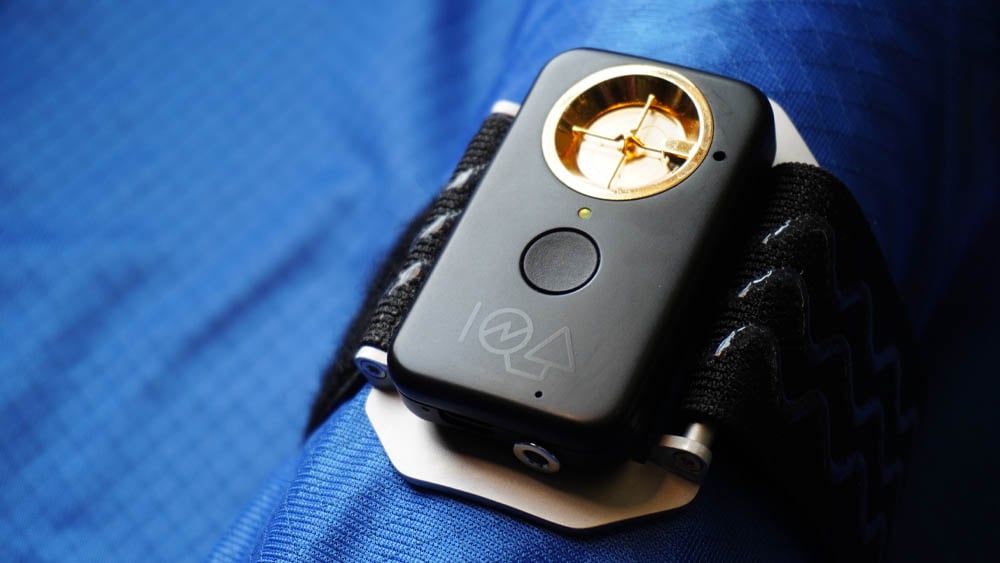This article is also available in Spanish.
The StatIQ™ ESD Monitoring System is the first of its kind to provide real-time, wireless body voltage monitoring for all users in an ESD Protected Area (EPA).
Traditional ESD monitoring products have limitations that render them challenging to employ and unreliable. The StatIQ™ ESD Monitoring System overcomes these limitations with its innovative design. The system comprises a wearable armband that measures the user’s electrostatic charge in real-time. When the user’s charge exceeds a preset threshold, the armband emits an audible alarm. The armband also records data on all ESD events, including the time, date, location, and severity of the event for better transparency and efficient problem-solving.
The armbands’ data is transmitted wirelessly to a central hub, which then sends it to a cloud-based server. This allows users to access the data from any internet-connected device. The data gathered improves ESD mitigation practices thanks to providing ESD managers with event tracking over time to identify trends and address issues.
The StatIQ™ ESD Monitoring System is the most advanced ESD monitoring system available today. By providing real-time, wireless tracking for all users in an EPA, businesses of all sizes can seamlessly reap the benefits of this innovative technology.
Conventional Human Body Voltage Measurements
Industry-standard systems for measuring human body voltage rely on a handheld probe that is connected by wire to a surface voltmeter. This voltmeter measures the electric potential of a charged plate connected to the user, so as not to drain or affect the charge on the body. Some of these meters are handheld devices but still require a tethered reference to Earth ground.
Now imagine having access to this data in real-time for all users of a facility requiring no tethers, that is the StatIQ™ ESD Monitoring System.

On Body Electric Field Measurements
Electric voltage measurements are, by definition, a measure of the difference, or delta of electric potential. Therefore, voltage measurements require a reference to some ground. Electric charge, on the other hand, is absolute. When the human body is at a non-zero potential, it contains a net electrostatic charge q. Because the body is a conductor, this charge is distributed along its surface with local surface charge density σ [Coulomb/m2 ], where q = ∫ σdA. This charge density cannot be measured outright, but due to the fundamental properties of electrostatics, it can be inferred by measuring the local electric field on the surface. Consider the Gaussian surface on a conductor in Figure 4. The electric field adjacent to the surface is known to be perpendicular because any orthogonal component would rearrange the charge distribution until the field is perpendicular. By the same argument, the electric field inside the conductor is zero. If Gauss’ law in Eq. 1 is applied to the cylindrical surface in Figure 4 with infinitesimal height and small radius R, Eq. 3 results because the dot product exists only on the top edge of the cylinder. This dictates that the electric field E measured at the surface of a conductor is directly correlated to the underlying surface charge density σ.

The StatIQ™ wireless body voltage monitor contains a proprietary field mill of unprecedented size and accuracy which measures the local electric field, and the underlying charge density on the user’s arm. As the shutter of the field mill rotates, the stationary electrode pairs are alternatively exposed to and occluded from the external electric field. The resulting AC signal is amplified and filtered in hardware, while software algorithms determine the resulting magnitude and polarity of the electric field with high accuracy. The measurement is especially agnostic to drift and offset from ionic air particles as they are equally absorbed by both electrodes, which is important in EPAs that rely on the use of air ionizers.
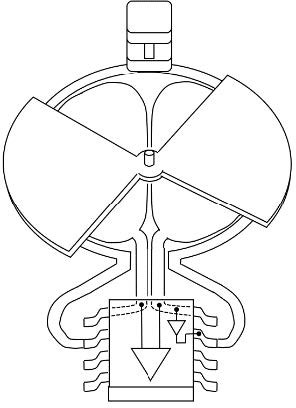
Relation Between Electrostatic Potential and Charge Density
So how does the charge density of the human body relate to its electric potential? The total charge is related to voltage by q = CV, where C is the body’s self-capacitance. For a simple sphere, capacitance can be calculated as C = R/k (where k is Coulomb’s constant), and the charge is equally distributed along the surface of the sphere. For a complex object like the human body, the charge distribution is nonlinear and depends heavily on its geometry. It can be calculated numerically by solving the differential form of Gauss’ law (Poisson’s equation).
By meticulously comparing StatIQ™ wireless body voltage monitor data to human body voltage measurements, it has been empirically verified that the field measurement at the upper arm tracks the human body voltage with high linearity. At extremities with sharp geometries (such as hands and feet), high charge concentrations can exist, which is why the StatIQ™ Band is located at the upper arm, whose position does not vary dramatically relative to the body’s core.
The StatIQ™ Band measurement can therefore be used as a proxy for the electric potential of the human body, in so far as is necessary to determine undesirable ESD conditions.
Vbody ∝ Earm (4)
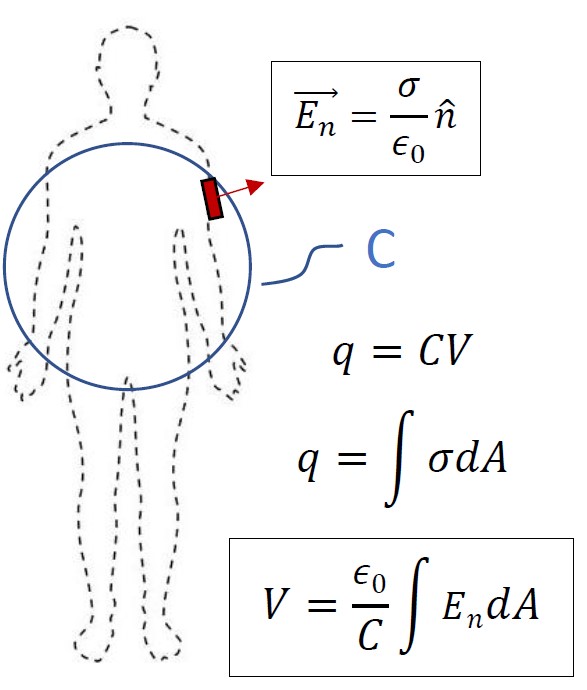
The plot in Figure 6 shows a comparison of StatIQ™ Band E-field measurements [V/m] multiplied by a constant factor according to the average human body capacitance (which gives a good conversion from V/m to V for most body sizes), compared with human body voltage measurements from an AlphaLab SVM2 Surface DC Voltmeter. Other systems such as the Prostat PGA-710 were also used for testing, but the Alphalab was found to have the least drift, fastest response, and highest accuracy. The measurements agree to high accuracy while the user performs four walking test sequences–two on a conductive floor and two on a non-compliant carpet.
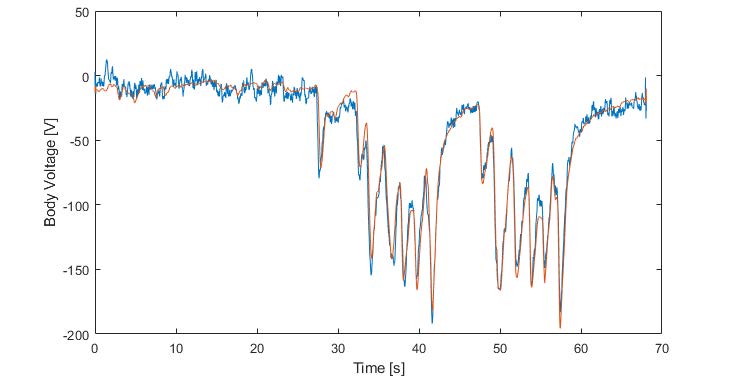
Minimal deviations between human body voltage and the local charge density measurement are possible, for example, when the user’s capacitance changes slightly due to varying body positions. Another scenario exists where nearby objects result in induced charges in the body and the charge distribution becomes non-symmetric. Without diminishing the value of body voltage measurements, we have come to realize that the charge density measurement is more indicative of impending ESD events than the body voltage. For example, the charged engineer in Figure 7, who is about to fry an expensive sensor, will experience a higher charge density at the location of the impending ESD event due to induced charges from the grounded workpiece.
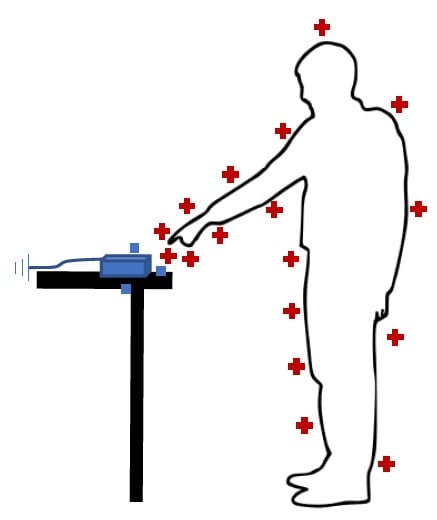
ESD Detection with the StatIQ™ Wireless Body Voltage Monitor
Existing ESD Event Detection devices rely on the detection of electromagnetic waves generated during the occurrence of an ESD event. In order to convert this to a voltage drop, accurate knowledge of the distance from the meter to the location of the ESD event is required. They rely on the device being stationary relative to a specific workpiece to gather useful ESD event data only for that specific workpiece.
The electric field mill of the StatIQ™ Band has an internal sampling rate of 1200 Hz (832 µs period). Therefore, the microcontroller can detect the rate of change in the electric field, and thereby the human body voltage, with great accuracy. This allows for an ESD detection algorithm that identifies rapid voltage changes which can only happen by a sudden transfer of charge from a grounding event. These events are distinguishable from triboelectric and atmospheric charge transfers and can be detected at voltage deltas much smaller than what is humanly perceptible as an electrostatic shock. It is these low-voltage ESD events that are most concerning in an ESD environment, as they go unnoticed and can cause latent damage to electronics. With the patent-pending StatIQ™ System, these events are easily and reliably identified.
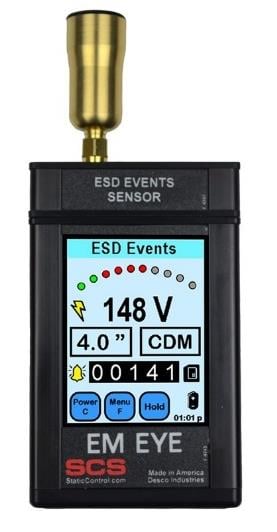
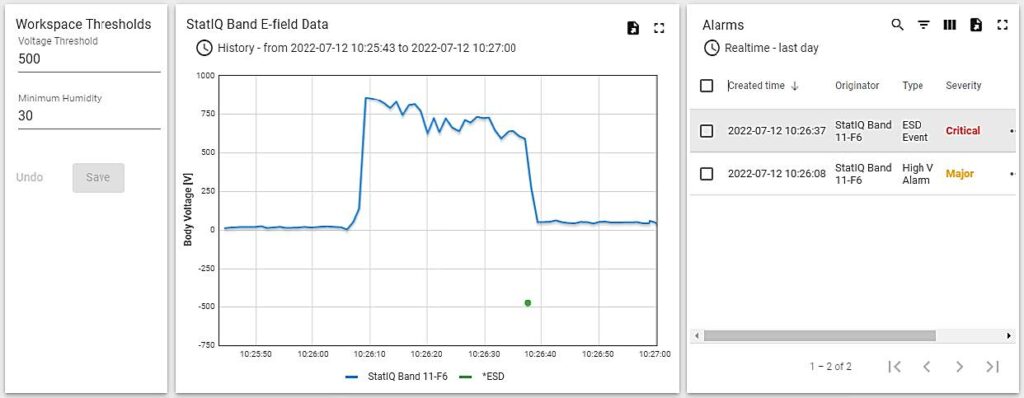
The above screenshot of the StatIQ™ Dashboard shows a user who was charged up by getting up out of a non-compliant chair, walking around for 30 seconds on noncompliant flooring, and consequently touching an Earth ground point. Alarms are generated when the preset voltage threshold is surpassed, and when the grounding ESD event occurs. The user is also alerted of these ESD dangers via audible alarms, and therefore can easily avoid damage to sensitive electronic assets in the lab.
StatIQ™ Wireless Body Voltage Monitor from PAC
The StatIQ™ ESD Monitoring System is the market’s most advanced ESD monitoring system. By providing real-time, wireless body voltage monitoring for all users in an ESD Protected Area (EPA), users are ensured that everyone is protected from ESD damage, which can be costly and disruptive to businesses.
If you are looking for an ESD monitoring system that will give you better mobility and peace of mind, then StatIQ™ is the perfect solution for you. Request a free demo today to learn more about how the StatIQ™ can protect your business from ESD damage.

Related Posts
- Benefits of Wireless Mobility in Your Warehouse
Without mobility, business processes are tied to a desk and paper is used to distribute information. A paper driven process requires data to be handled multiple times leading to inefficient use of time and the…
- Three Ways Mobility Can Optimize Your Wireless Facility
Overview Thanks to wireless technology, mobile powered workstations (MPWs) are opening up a new frontier of efficiency and productivity. These workstations with integrated power supplies can maneuver computers, printers, scales, barcode scanners, ect., to wherever they are needed. For…
-
Optimize Your Wireless Facility: The Top Three Reasons to Implement Mobile Workstations
Thanks to wireless technology, mobile powered workstations (MPWs) are opening up new frontiers of efficiency and productivity. These workstations with integrated power supplies can maneuver computers, printers, scales, barcode scanners, etc., to wherever they are needed. For some…
-
Químico 3M ™ Novec™ saldrá del mercado: Aquí está el reemplazo que necesita
Artículo disponible en inglés. El 20 de diciembre de 2022, 3M™ anunció su intención de abandonar el mercado de las sustancias perfluoroalquiladas y polifluoroalquiladas (PFAS), retirando de forma efectiva 58 productos 3M™, incluidos todos los…
-
3M™ Novec™ Chemical To Exit Market: Here’s The Replacement You Need
This article is also available in Spanish. On December 20th, 2022, 3M™ announced its intended exit from the per- and polyfluoroalkyl substance (PFAS) market, effectively taking away 58 3M™ products, including all Novec™ PFAS products…
-
BenchPro™ stainless steel frame workbenches added to PAC product line
Production Automation Corporation is excited to announce that we are now offering BenchPro™ K, D, and A Series workbenches with stainless steel frames. High-quality, durable materials allow you to design and build just the right…

